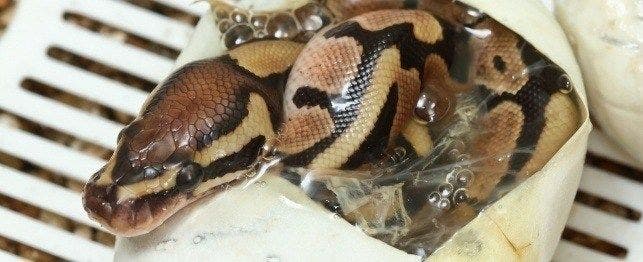
Reptile Reproduction: From Egg to Adult
How familiar are you with the “birds and the bees” of reptile reproduction? As reptiles increase in popularity, interest in breeding is growing. Other reptile owners are doing such a good job of caring for their pets that the herps are growing and reaching sexually maturity. For example, we’re seeing an unprecedented number of adult green female iguanas presented to veterinary clinics for problems related to egg laying.
Most reptiles lay eggs and are called oviparous. The act of laying eggs is called oviposition. Some reptiles bear live young and the term for this is viviparous. Technically, a female that lays eggs is said to be gravid when she’s holding eggs inside of her. She may also correctly be called pregnant. Below is a list of some of the more common species of reptiles and the method of reproduction they employ:
Reptiles That Lay Eggs
- All turtles
- All tortoises
- All crocodilians
- Some lizards
- Iguanas
- Water dragons
- Geckos
- Veiled chameleons
- Panther chameleons
- Monitors
- Snakes including: all pythons, kingsnakes, milksnakes, rat snakes and corn snakes
Reptiles That Bear Live Young
- Some chameleons
- Jackson’s chameleon
- Some snakes including: all boas; all vipers; garter snakes
- Some lizards including Solomon Island skink; blue-tongue skink; shingle-backed skink
Male and female reptiles don’t have external genitalia to help owners determine the sex of a herp. However, males and females do possess different reproductive organs. The male possesses two testicles, which are housed inside the body. He also has a copulatory organ, either a single penis (turtles and tortoises, crocodilians) or a pair of hemipenes (lizards, snakes) that can often be seen as two bulges behind the cloaca (the passage for the urinary and reproductive discharge) at the base of the tail.
The penis or hemipenis isn’t connected to the urinary tract and is strictly an organ of reproduction. Lizards and snakes can be sexed by the use of a probe that’s inserted into the cloaca, directed toward the tail, off of the midline. The probe will travel farther in the male than in the female.
Secondary Sex Characteristics
There are also secondary sexual characteristics that can help differentiate males from females. Often, in male chelonians (turtles and tortoises), the plastron (bottom shell) is somewhat concave and the tail is proportionally longer. Often, the head and general body size are proportionally larger in male reptiles. The male Jackson’s chameleon has three prominent horns on the head, which are lacking in the female.
Many male iguanids and geckos possess femoral or pre-anal pores that secrete a waxy substance making them more prominent than those found in females. Many boas and pythons possess spurs located on either side of the vent and, in many males, these spurs are larger.
In general, the tail of male reptiles is proportionally longer than the female’s. There are other ways to differentiate the sexes of reptiles, including ultrasound, surgical sexing and radiographs. For specific information, please consult your herp veterinarian if you’re unsure about the sex of your reptile.
It would seem that reproduction is a natural event but, without correct circumstances, such as a balanced diet and a suitable environment for egg-laying, eggs may not develop normally or be laid in a timely manner. Owners are often surprised to find that their single pet female lizard has developed eggs. A healthy adult female does NOT need the presence of a male to become gravid.
Fertilization
For fertilization, a male reptile inserts either the single penis or one of his two hemipenes into the female’s cloaca. Before actual copulation, the pair usually engages in some type of ritualized courtship. After copulation, sperm can be stored for up to 6 years. This stored sperm can fertilize subsequent clutches (groups of eggs) without additional contact by a male.
In the green iguana, for example, a healthy adult female may begin developing eggs even without a male present to fertilize eggs. The process begins with the ovaries, located inside the body, where eggs are stored. Most female green iguanas become mature when they’re between two and four years of age. At that time, follicles begin developing in the ovaries. Each follicle is composed of a tiny egg and a sac filled with yolk. The follicles then detach and move into the oviducts where the egg white is added, and then a shell is placed around the yolk and white.
The gravid female usually won’t eat for 3 to 6 weeks prior to laying her eggs. It makes sense since her abdomen will be full of eggs in the oviducts and her stomach is quite compressed, so there is little space for food in the stomach.